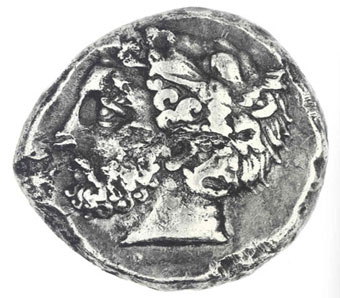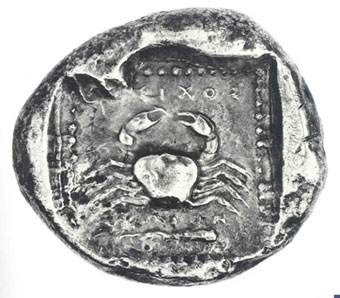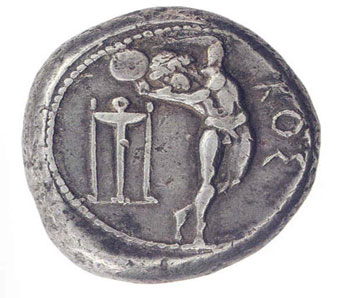Greek Islands Ancient Coins
"Kos Coin-Silver Tridrachm,Silver Tetradrachm"
Kos, the island of Hippokrates, has been continuously inhabited from the Early Helladic period to the present. One of the most important events in the islands' history was the synoecism - the amalgamation of the earlier settlements into a single city, which is believed to have occurred in 366 BC. After that date the island experienced an economic and cultural development that reached its zenith in the 3rd c. BC.
The rich numismatic output began in the Archaic period and continued down to Roman times. The crab, the main numismatic type of the island, is depicted on a rare Archaic stater. The famous tridrachm, the diskobolos of Kos, is one of the finest examples of the seal-engraver's art from about the middle of the early Classical period. The anonymous ancient artist has captured in the tiny circular surface of the coin the movement of the point in time at which the athlete is preparing to throw the discus. At the left is a depiction of the prize for the contest, a bronze tripod. The coin is dedicated to Apollo, in whose honour games were instituted by the cities of the Dorian Pentapolis: Lindos, Ialysos, Kamiros, Knidos, and Kos.
In the later issues - the tetradrachms and smaller subdivisions of the 4th c. BC - the depictions are associated with the legend of Herakles and the Lernaian Hydra, and in general with the cult of the hero on Kos. They have the head of Herakles wearing the lion-skin headdress on the obverse, and the crab on the reverse.
The plinthophoroi drachms of the 2nd c. BC, which were minted on the Rhodian standard, are dedicated to the cult of the god Asklepios; the famous Asklepieion, a temple tot his god, stood on the island from the middle of the 4th c. BC onwards. The head of Asklepios crowned with a laurel wreath on the obverse is accompanied by a snake in an incuse square on the reverse. The representation is supplemented by the inscription of the ethnikon and the name of the official responsible for the mint.








